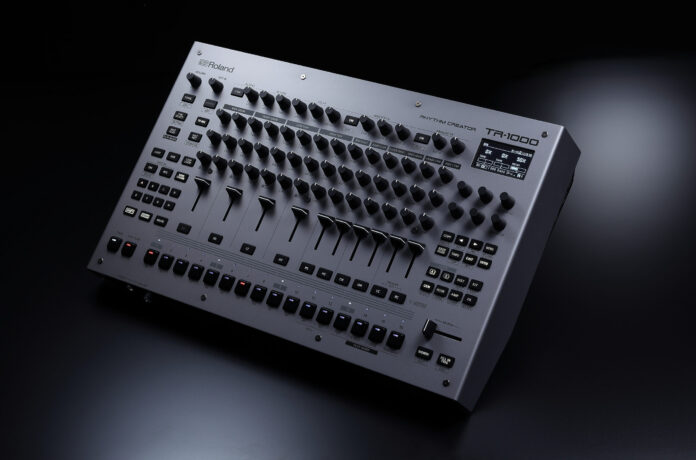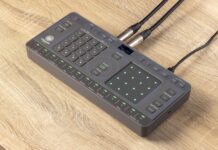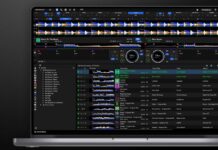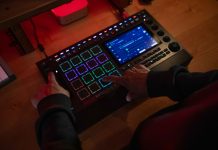Roland announced the new TR-1000 Rhythm Creator today: a $2,699 USD drum machine that blends digital sound engines and analog circuitry with new sampling abilities, all in one heavy-hitting piece of hardware. It weighs in at just over 12 lbs and is built at ~19″-wide x ~12″-deep x ~15″ high. It’s the first true analog TR from the company in over 40 years. If the 808 and 909 defined entire movements of music, the TR-1000 feels positioned as their rightful successor – one that nods to history while embracing modern producers’ hybrid workflows.
Key Features
More than just a drum machine, the TR-1000 expands into a larger ecosystem built with producers in mind. Here’s a few of its most significant features:
- Analog circuits, re-introduced: 16 circuits from the TR-808 and TR-909 faithfully recreated with modern components.
- Multi-engine power: Analog, ACB digital models, FM percussion, VA tones, and a large PCM sample library.
- Built-in sampling: The TR-1000 comes with 64 GB of onboard memory (46 of which are user-available), stereo sampling, time-stretching, slicing, and resampling.
- Performance tools: including the Morph slider, snapshot recall for knob positions, off-grid sequencing options, per-track effects, and LFOs.
- Integration-ready setup: Flexible routing, internal sidechaining capability, expanded I/O
- New TR-1000 desktop app: built for control, editing, and library management.
Watch this 12-minute video from the Roland team for a deeper dive at the TR-1000’s swath of capabilities:
Analog and digital, side by side
At the core of the TR-1000 are 16 analog voice circuits lifted straight from the previous TR-808 and 909 designs and rebuilt with modern components. For anyone who’s ever chased that low-end thump of an 808 kick or the snappy crack of a 909 snare, this is the first Roland box in decades that will actually move air the way the originals did – without relying on emulation.
Alongside the analog engine are 21 ACB (Analog Circuit Behavior) models, plus FM percussion for metallic tones, virtual analog voices, and a deep PCM library. This combination makes the TR-1000 less of a nostalgia piece and more of a sound-design workstation. You can blend an analog kick with an ACB snare, stack FM toms for unusual attack, and throw resampled textures into the mix – all from the same sequencer grid.
With this in mind, consider a few use-case scenarios here: For a techno live act, that could mean running a pure analog 909 core while morphing layers of FM percussion into noise-heavy crescendos. A trap or hip-hop producer might lean on the analog 808 subs for their foundation while slicing and pitching samples on top for hooks. A modular artist could use the PCM and digital engines as a palette of source material, routing analog voices out through pedals or Eurorack filters while sequencing everything inside the TR-1000.
The point is simple: this isn’t just Roland “bringing analog back.” It’s giving producers the ability to mix and match eras, textures, and workflows in ways the original TRs could never touch.
Sampling that feels natural
Sampling on older TR boxes often felt bolted on. The TR-1000 finally makes it central to the workflow. You get stereo sampling, BPM-sync, non-destructive slicing, and real-time resampling. With 64 GB onboard (46 GB free for your own material), it’s practical for more than just a handful of hits with its ability to store entire libraries.
This piece of gear is clearly filled with both live set and studio potential that extends beyond more than your everyday tool for bedroom producers. You can run drum racks alongside modular percussion loops, capture them into the machine, and twist them in real time. For hip-hop beatmakers, that might mean flipping vinyl one-shots into TR patterns without ever opening a DAW. A techno or house producer could layer field recordings like room ambience or metallic scrapes over the analog core to push percussion into darker territory. Live performers could even utilize the resampling workflow to build evolving textures and loops mid-set – keeping everything inside the hardware without breaking momentum.
Sequencer evolution: groove in your hands
The TR sequencer is famous for its 16-step immediacy, and the TR-1000 builds on that with new expressive tools. Off-grid programming lets you fine-tune swing and pocket beyond basic shuffle; instead of nudging in your DAW, you can shape the groove directly on hardware. The Morph slider introduces sweeping transformations including kit morphing, FX shifts, and parameter blends – all in real time – and the snapshot system acts like performance macros, which lets you punch in whole knob states on the fly.
For a gear head, this means serious improvisational potential. Think: flipping from a dry 909 kit to a fully distorted warehouse thumper with one button press, or gradually morphing a minimal groove into glitchy chaos mid-set. It’s the kind of live performance control that moves the TR beyond static pattern playback into the realm of improvisation-heavy machines like Elektron.
Ultimately, the key shift is that groove-shaping – something typically left to post-production in a DAW – now feels tactile and playable in the moment.
Built for the hybrid studio
Roland knows that modern producers don’t live in one world anymore. Rather, they’re half in the DAW and half in hardware – often with a pedalboard or modular rig on the side. The TR-1000 is designed to slot into that reality. Multiple outputs, flexible routing, per-track effects, and internal sidechaining mean you can treat it as the heart of your setup or as a piece that locks in alongside others.
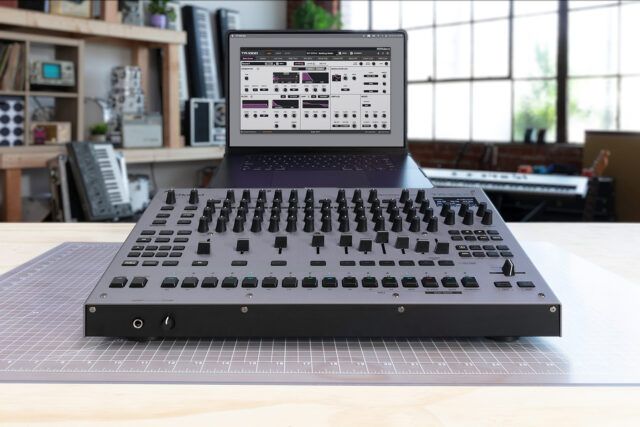
The companion TR-1000 App extends that flexibility, offering visual editing, library management, and parameter control from a computer. For DAW-focused workflows, you can route individual voices through an interface for plugin processing while keeping the sequencer as the rhythmic brain. Modular users might clock Eurorack from the TR-1000, send its analog kick through a filter module, and resample it back for layering. Pedal users can run snares or hats into distortion, delay, or granular stompboxes to get textures no plugin quite nails.
Overall, the design takeaway here is that Roland didn’t create this as a closed system. The TR-1000 is meant to anchor a setup when you want it to, but it’s just as happy sitting alongside other machines, modular racks, pedalboards, or DAW channels.
From the 808 to the 1000: A Legacy of Rhythm
There’s no question that Roland’s TR line is more than a product family; it’s the DNA of modern electronic music. The warm boom of the 808 kick, the tight crack of the 909 snare are beloved sounds that have become a rhythmic backbone of genres across the board – from house, techno and hip-hop to trap and pop down the road. When producers in the early ‘80s first got their hands on the 808, they weren’t just programming drums – they were writing the grammar of new genres.
The TR-1000 arrives with the weight of that history but also a sense of renewal. Where the 808 and 909 were limited by the technology of their time, the TR-1000 fuses analog circuits with flexible digital sound design and integrated sampling. It’s designed to push rhythm forward for a new generation of producers who expect their gear to be both tactile and flexible with a variety of options and abilities at its fingertips.
Culture and cost
The TR-1000’s $2,699 USD price tag places it in flagship territory, but its feature set backs it up. Elektron’s Analog Rytm MKII and Akai’s MPC Live II both offer hybrid workflows at lower prices, but neither brings Roland’s analog TR DNA into the equation. For producers who want “the real circuits” with modern flexibility, that premium might feel justified.
Culturally, the TR-1000 represents Roland reasserting itself as not just a legacy brand, but an innovator willing to merge analog circuitry with forward-facing design. It’s a reminder that the TR isn’t stuck in the past. Rather: it’s alive, evolving, and ready to anchor the next chapter of rhythm culture.
Final thoughts
The TR-1000 takes the TR heritage seriously, giving purists analog authenticity while offering deep sampling, digital expansion, and performance features that today’s producers will actually use, designed for a studio-to-stage artist workflow with tactility and versatility.
Is it the “next era of rhythm” as Roland calls it? Maybe. However, even if you set aside the marketing slogans, what Roland has built here is a drum machine that’s both a love letter to its history and a serious tool for modern producers. For anyone who cares about rhythm and wants their instrument to punch as hard as their ideas, the TR-1000 is easily one of the most exciting Roland releases in decades.
The TR-1000 Rhythm Creator is out now, priced at $2,699.99. Grab it from the DJ TechTools shop here.

